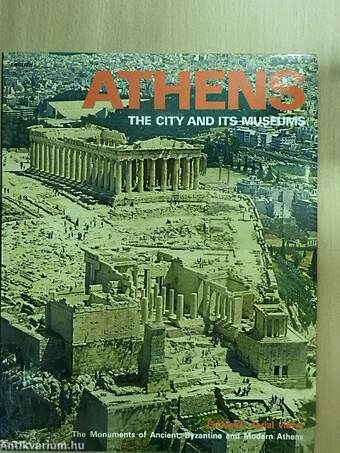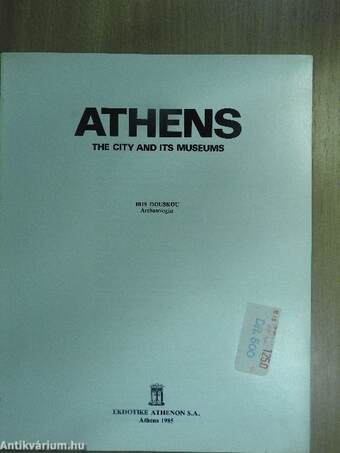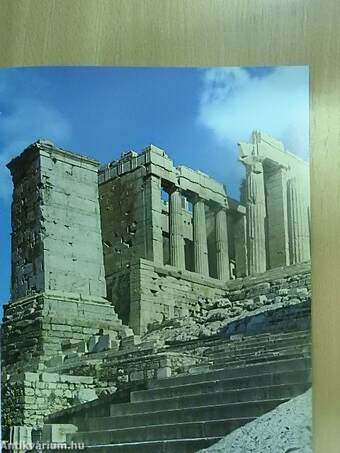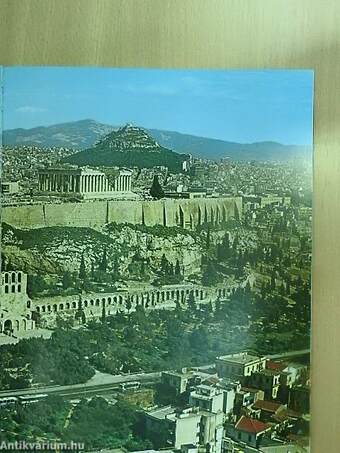1.117.990
kiadvánnyal nyújtjuk Magyarország legnagyobb antikvár könyv-kínálatát
Athens
The City and its Museums/Exclusive aerial views: The Monuments of Ancient, Byzantine and Modern Athens
| Kiadó: | Ekdotike Athenon S. A. |
|---|---|
| Kiadás helye: | Athén |
| Kiadás éve: | |
| Kötés típusa: | Fűzött papírkötés |
| Oldalszám: | 110 oldal |
| Sorozatcím: | |
| Kötetszám: | |
| Nyelv: | Angol |
| Méret: | 27 cm x 21 cm |
| ISBN: | |
| Megjegyzés: | Színes fotókkal, térképpel. |
naponta értesítjük a beérkező friss
kiadványokról
naponta értesítjük a beérkező friss
kiadványokról
Előszó
Athens
A Historical Outline
1. Even today the rock of the Acropolis stands out amidst the Athenian landscape. (Special aerial photograph.)
2, 3. Athens in the last century. >
Athens today... Tovább
Előszó
Athens
A Historical Outline
1. Even today the rock of the Acropolis stands out amidst the Athenian landscape. (Special aerial photograph.)
2, 3. Athens in the last century. >
Athens today occupies almost the entire Attic plain, extending in a semicircular sweep to the foot of Mount Parnes, Hymettus, and Penteli. An aerial view of the city gives the impression of a vast, gray sea of buildings threatening to submerge the few remaining green hillocks in its effort to climb ever higher up the sides of the surrounding mountains. The population of the city of Athens, including that of the port of Piraeus, is now almost 3.5 millión, that is, more than 1/3 of the country's entire population.
In ancient times, the city was considerably smaller. Initially, it was confined to the site of the Acropolis proper; in itself, the rock provided a natural focal point for an expanding and thriving city.
Following the end of the Geometric period, and as a result of the many reforms introduced by Solon, Cleisthenes, and Ephialtes, the political institutions of the Athenian city-state underwent far-reaching changes. For one, the seat of government was moved from the Acropolis — where the Mycenaean king originally had his throne — to the Agora, which in time became the civil, administrative, and judicial centre of the state, and eventually a symbol of Athenian democracy.
By the 5th century b.c., only the architecture of temples and other public buildings was monumental; priváté houses were now built in a simple style, while the streets running between them were extremely narrow by modern standards.
As a result of Pericles' vigorous and imaginative public works programme — carried out when Athens was at the height of its power — the physical aspect of the city changed radically. Its beauty now came to equal its political prestige and preeminence in the Greek world.
Despite its defeat in the Peloponnesian War, for Athens the 4th century was a period of comparative prosperity, as indicated by the advances made in domestic architecture. However, following Philip IInd's ascendancy in southern Greece, and Alexander the Great's victorious campaigns, the Athenian city-state soon feli into political decline. Yet, the city's renown as a great artistic and cultural centre remained undiminished. Thus, during the Hellenistic period, the kings would continue to make osten-tatiously generous gifts to the once great city, as a way of enhancing their own personal prestige. During this period, the Attalid kings of Pergamon in Asia Minor, and the Ptolemy kings of Egypt built a num-ber of stoas and gymnasia, or had sumptuous votive offerings set up on the Acropolis itself. Vissza
Tartalom
Contents
ATHENS
A historical outline 7
THE ACROPOLIS
The Propylaia, the Parthenon, the temple ofAthena Nike, the Erechtheion 10
THE ACROPOLIS MUSEUM
Archaic art, the Parthenon sculptures 26
ANCIENT THEATRE
The theatre of Dionysus, the Odeum of Herod Atticus 32
THE ANCIENT AGORA
The temple of Hephaestus and Athena, the stoa of Attalus, the Román Markét 36 THE AGORA MUSEUM 42
AROUND THE ACROPOLIS
The Areopagus, the Pnyx, the Hill of Philopappus, the monument of Lysicrates 44 THE OLYMPIUM
The temple of the Olympian Zeus, Hadrian 's A reh, the Ilissos river area 46
KERAMEIKOS
The Dipylon, the museum 48
SOUNION
The temple of Poseidon, the sanetuary of Athena 51
BRAURON
The sanetuary of Artemis, the museum 54
ELEUSIS
The temple of Demeter, the Eleusinian mysteries, the museum 56
THE NATIONAL ARCHAEOLOGICAL MUSEUM
Archaic and classical art, the collection of bronzes 58
BYZANTINE ATHENS
Panagia Gorgoepikoös, Kapnikarea 70
KAISARIANI
The monastery, Mount Hymettus 72
DAPHNI
The monastery, the mosaics 74
THE BYZANTINE MUSEUM
Byzantine sculptures, Byzantine andPost-Byzantine icons, miniatűré art 78
THE BENAKI MUSEUM
Greek folk art, icons, wood carvings, embroideries 82
THE MUSEUM OF NATIONAL HISTORY
The old Greek Parliament house, the collection of the Historical and Ethnological Society 86
THE NATIONAL GALLERY
Greek and European painters 88
ATHENS TODAY 93
PIRAEUS
The port, Zea and Mikrolimano, the Castella Hill, the museums 105
Témakörök
- Idegennyelv > Idegennyelvű könyvek > Angol > Művészetek > Fotóművészet
- Idegennyelv > Idegennyelvű könyvek > Angol > Művészetek > Művészettörténet, általános
- Idegennyelv > Idegennyelvű könyvek > Angol > Művelődéstörténet
- Idegennyelv > Idegennyelvű könyvek > Angol > Helytörténet
- Művelődéstörténet > Intézményei > Múzeumok
- Helytörténet > Külföldi > Városok
- Helytörténet > Helyismeret > Intézmények
- Művészetek > Művészettörténet általános > Múzeumok, képtárak > Külföldi > Európai
- Művészetek > Művészettörténet általános > Idegen nyelv > Angol
- Művészetek > Fotóművészet > Albumok > Tematikus
- Művészetek > Fotóművészet > Idegen nyelv > Angol
- Művészetek > Fotóművészet > Témái > Városok > Külföldi
Iris Douskou
Iris Douskou műveinek az Antikvarium.hu-n kapható vagy előjegyezhető listáját itt tekintheti meg: Iris Douskou könyvek, művekMegvásárolható példányok
Nincs megvásárolható példány
A könyv összes megrendelhető példánya elfogyott. Ha kívánja, előjegyezheti a könyvet, és amint a könyv egy újabb példánya elérhető lesz, értesítjük.








